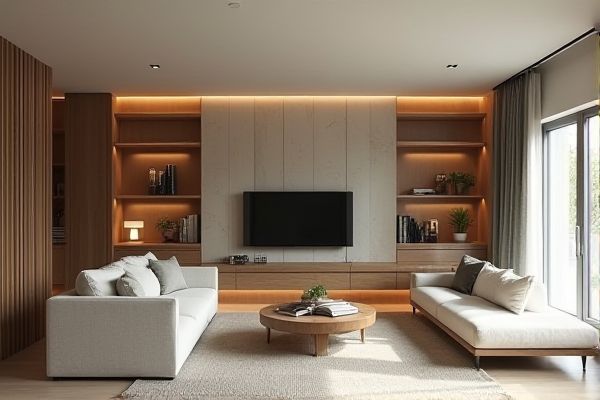
Open riser stairs feature gaps between each step, allowing light and air to pass through, creating a modern and spacious aesthetic, while closed riser stairs have solid vertical panels that provide a more traditional and enclosed feel. Explore our detailed comparison to determine which stair design best suits Your space and style preferences.
Table of Comparison
| Feature | Open Riser | Closed Riser |
|---|---|---|
| Design | Open gaps between steps | Solid vertical panels between steps |
| Light Flow | Allows more natural light | Limits natural light flow |
| Safety | May be less safe for children/pets | Safer with solid barriers |
| Visual Impact | Creates an airy, modern look | Offers a traditional, solid appearance |
| Noise | Typically louder footsteps | Reduces noise between steps |
| Installation Cost | Usually lower cost | Often higher cost |
| Maintenance | Easier to clean under stairs | May accumulate dust on risers |
Introduction to Open vs Closed Risers
Open risers feature visible gaps between each stair tread, enhancing light flow and creating a modern, airy aesthetic often preferred in contemporary architecture. Closed risers consist of solid vertical panels beneath each tread, providing a traditional, sturdy appearance that improves safety by preventing objects from falling through. Choosing between open and closed risers depends on design preferences, safety requirements, and spatial considerations.
Key Differences Between Open and Closed Risers
Open risers feature gaps between each step, allowing light to pass through and creating a more airy, modern appearance ideal for contemporary interiors. Closed risers have solid vertical boards connecting each tread, offering enhanced structural support, improved safety for children and pets, and reduced sound transmission. The choice impacts aesthetics, safety, and maintenance, with open risers often requiring stricter building codes and closed risers providing a traditional, enclosed stair design.
Aesthetic Appeal: Modern vs Traditional Looks
Open riser staircases provide a sleek, modern aesthetic that enhances light flow and creates an airy, minimalist appeal ideal for contemporary interiors. Closed risers offer a more traditional, solid appearance that emphasizes classic design and structural completeness, making them suitable for formal and historic settings. The choice between open and closed risers significantly influences the staircase's visual impact and overall architectural style.
Safety Considerations and Building Codes
Open risers present safety concerns such as increased risk of falls, especially for children and pets, due to the gap between steps, which building codes often limit or regulate. Closed risers enhance safety by eliminating gaps, providing greater structural integrity and meeting stricter building code requirements in residential and commercial properties. Ensuring your staircase complies with local safety standards helps prevent accidents and aligns with regulations for both open and closed riser designs.
Maintenance and Cleaning Requirements
Open riser staircases require more frequent cleaning due to the exposed undersides of each step, where dust and debris can accumulate, making maintenance more demanding compared to closed risers. Closed riser stairs feature solid vertical panels between treads, which not only enhance structural integrity but also simplify cleaning by minimizing dust buildup and hiding dirt. Your choice between open and closed risers impacts ongoing upkeep, with closed risers offering easier maintenance in environments where cleanliness is a priority.
Structural Strength and Durability
Open risers in staircases offer modern aesthetics but generally have reduced structural strength compared to closed risers due to the absence of vertical support between treads. Closed risers contribute to greater durability and load-bearing capacity by reinforcing the stair structure and distributing weight evenly. Materials like hardwood or steel used in closed riser designs enhance long-term stability, critical for high-traffic areas requiring robust performance.
Cost Comparison: Materials and Installation
Open riser staircases typically cost less in materials due to reduced use of wood or metal panels, but installation might require more precision and labor to ensure safety and compliance with building codes. Closed riser stairs involve additional materials for the vertical panels, increasing overall material expenses, yet their installation tends to be simpler and faster, potentially lowering labor costs. When budgeting for your staircase project, consider that open risers may offer material savings but could incur higher installation costs compared to closed risers.
Impact on Lighting and Space Perception
Open risers allow light to flow freely between steps, creating a brighter and more spacious atmosphere in your interior, while closed risers block light, resulting in a more solid and traditional staircase appearance. The transparency of open risers enhances spatial perception by reducing visual obstruction, making rooms feel larger and more open. Closed risers, by contrast, provide a defined and enclosed look that can make a space feel more compact and cozy.
Suitability for Different Interior Styles
Open riser stairs impart a modern, minimalist aesthetic ideal for contemporary and industrial interior styles, enhancing light flow and creating an airy ambiance. Closed riser stairs offer a more traditional, formal appearance suited for classic, rustic, or transitional interiors by providing a solid, enclosed structure that adds warmth and privacy. Choosing between open and closed risers depends on the desired stylistic impact and the functional needs of the living space.
Choosing the Right Riser Type for Your Project
Choosing the right riser type for your project depends on factors like safety, aesthetics, and building codes. Open risers create a modern, airy look but may require additional safety measures, especially in homes with children or pets. Closed risers offer enhanced structural support and privacy by eliminating gaps, making them ideal for traditional designs or locations demanding extra security.
 homyna.com
homyna.com